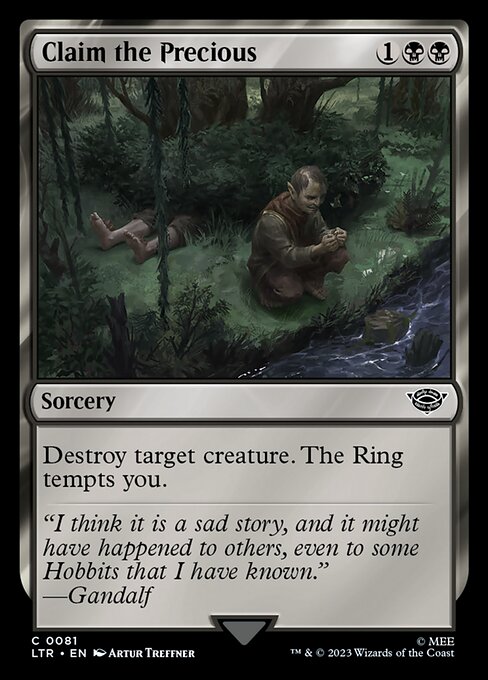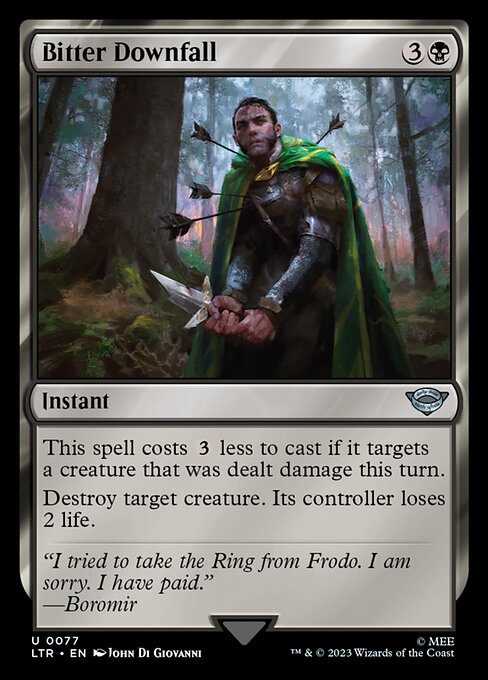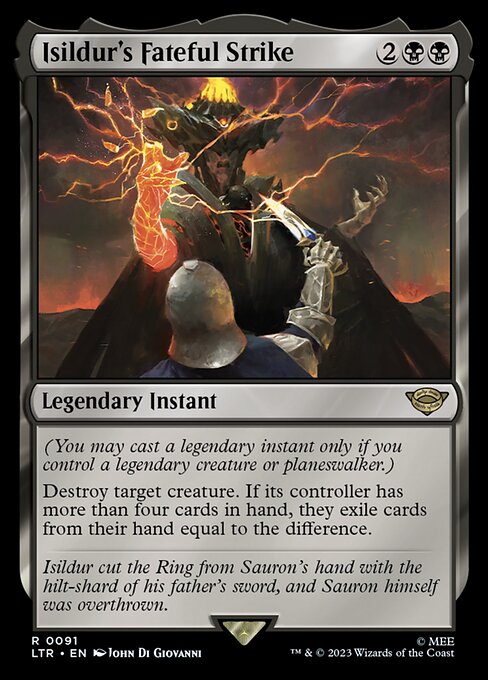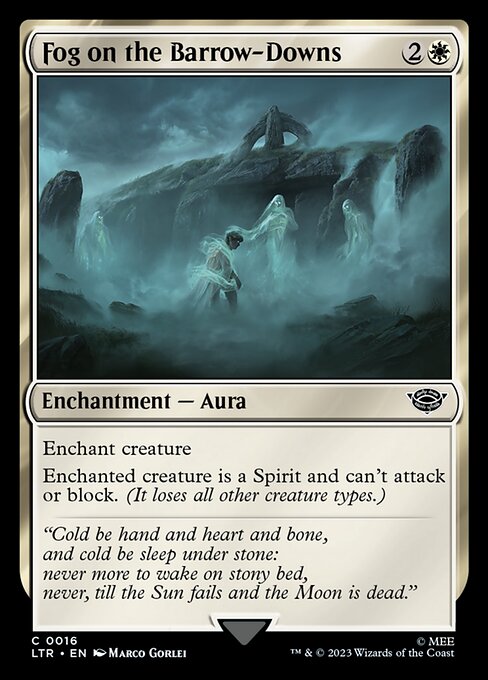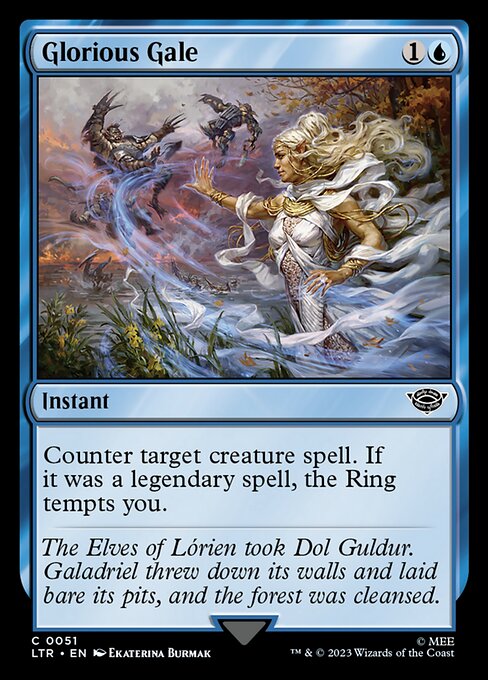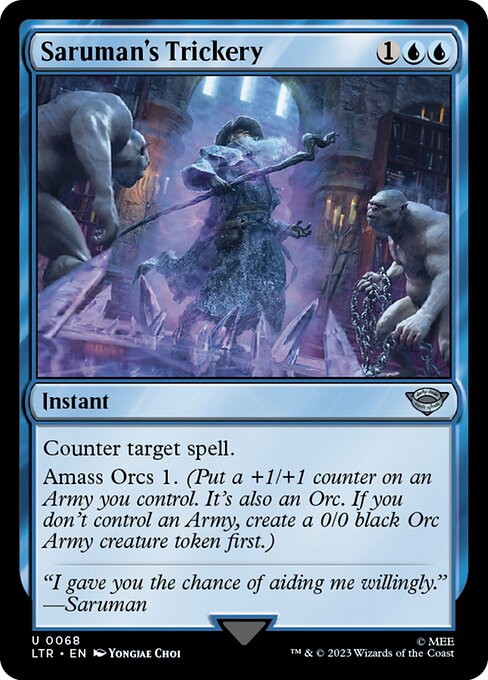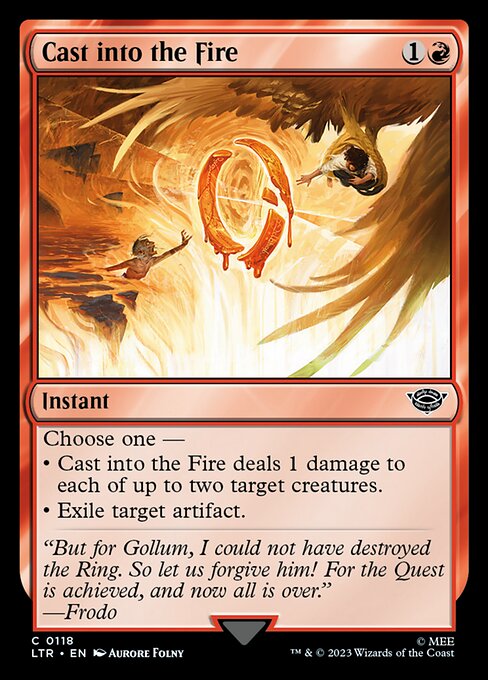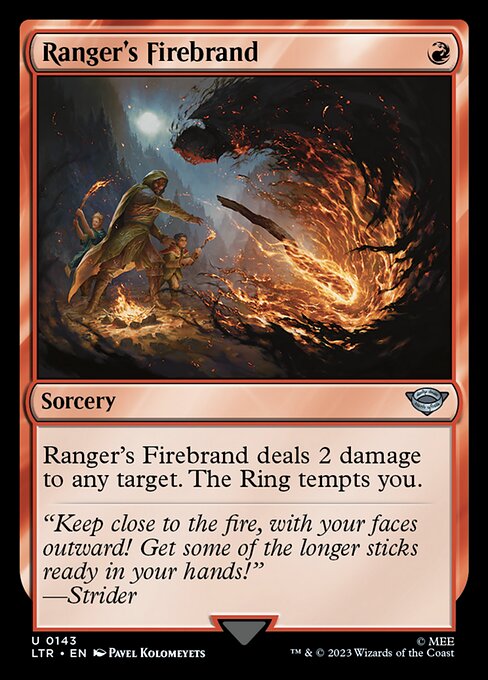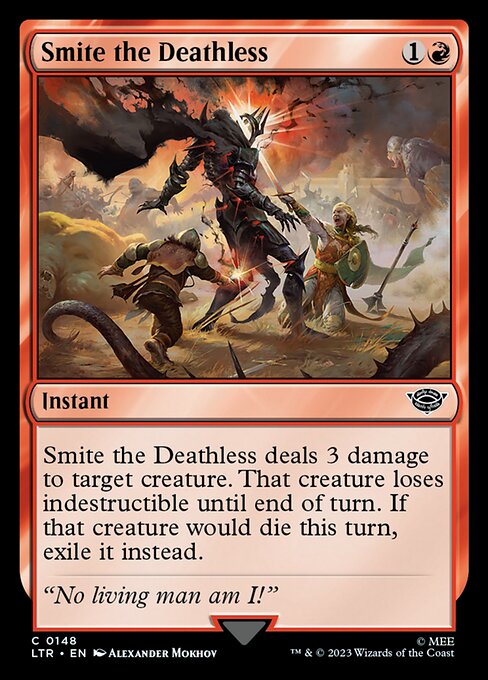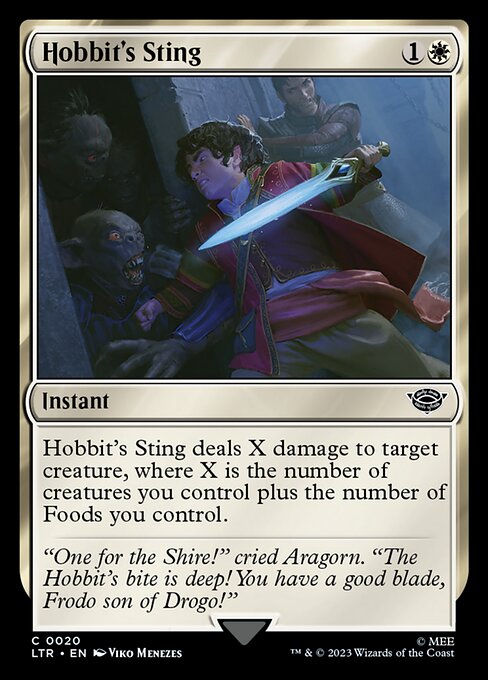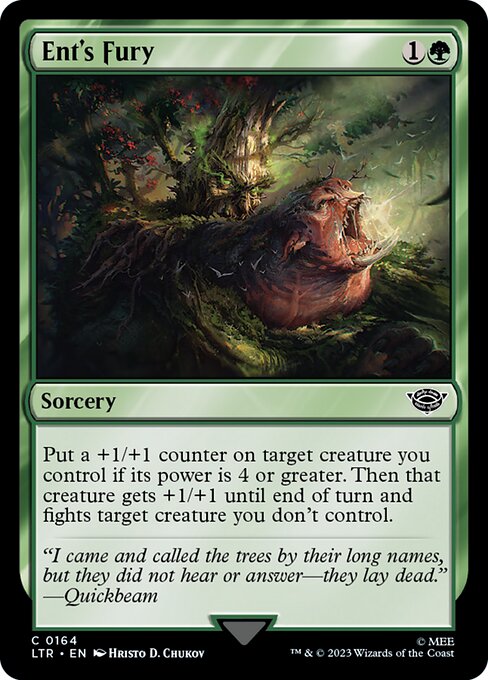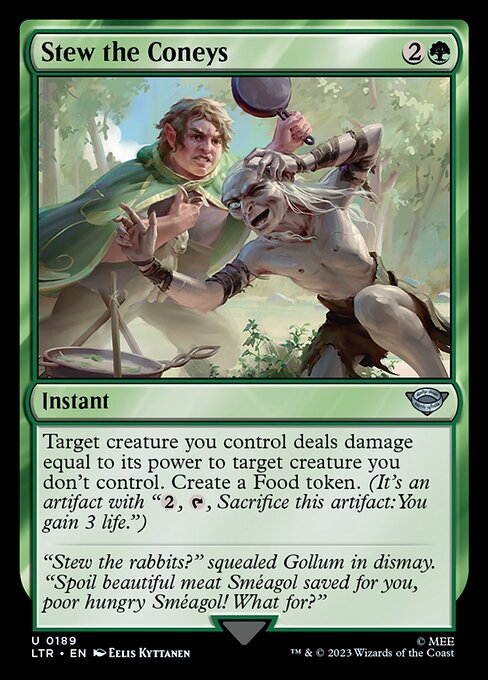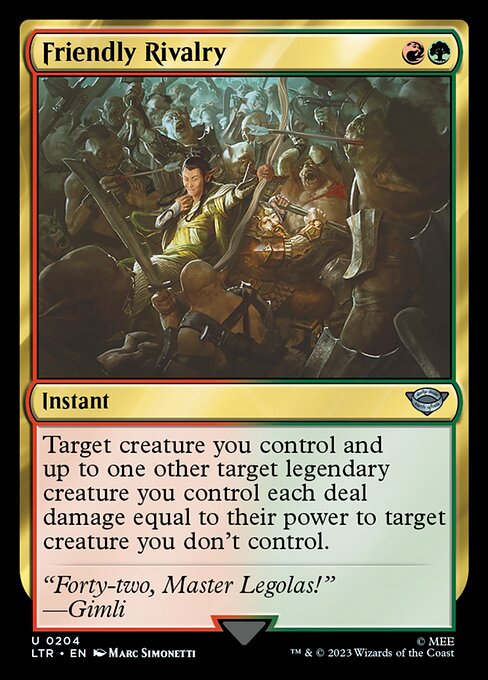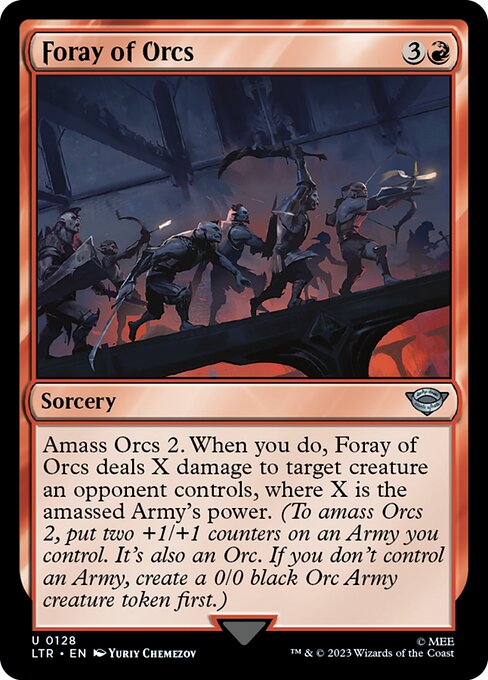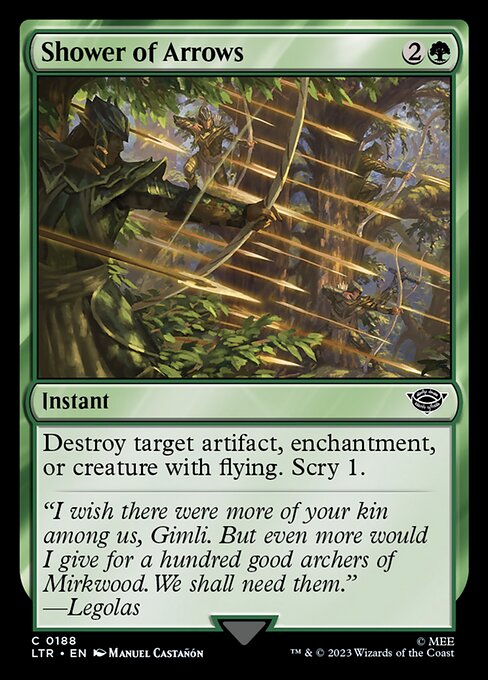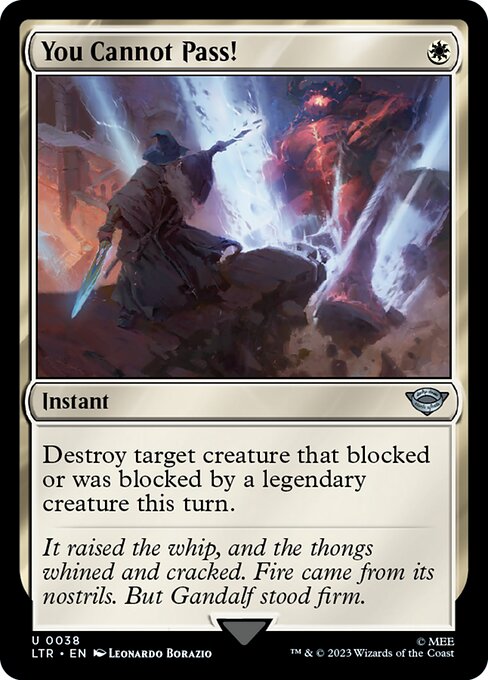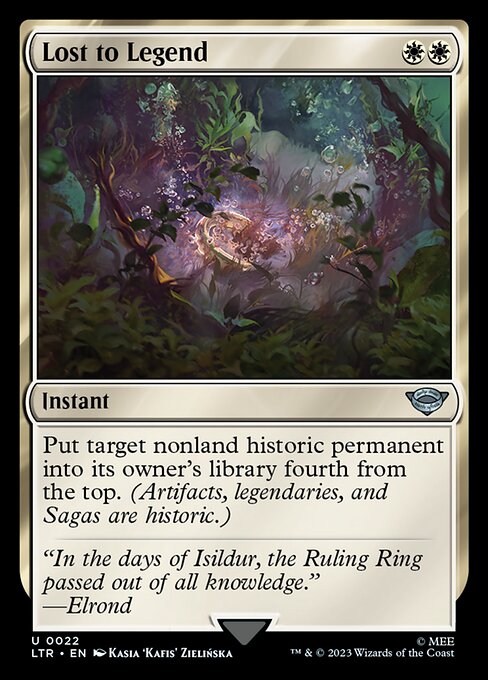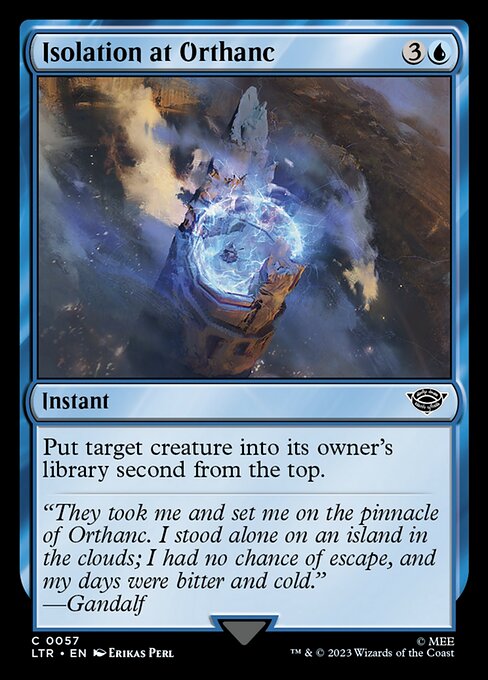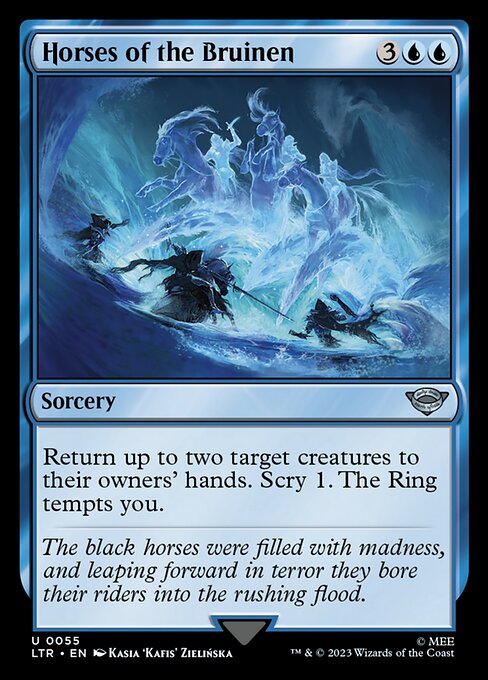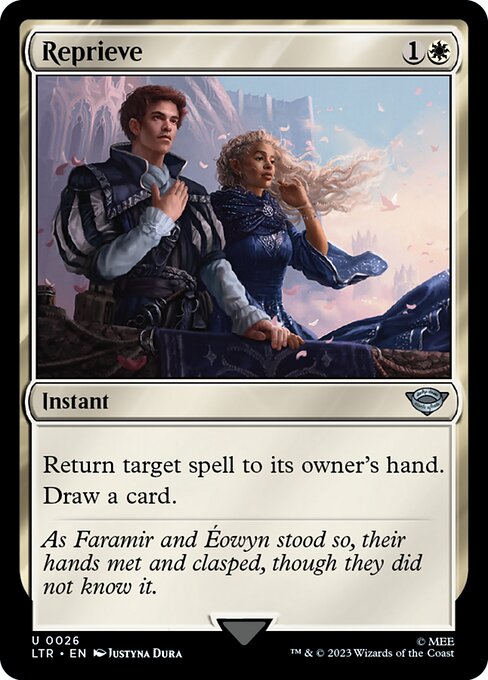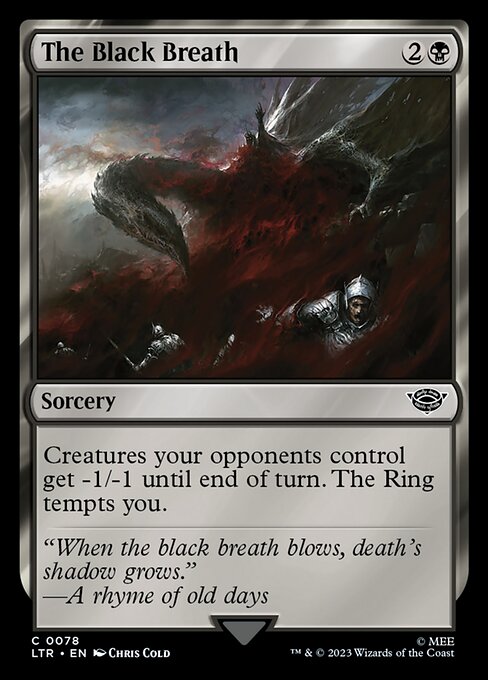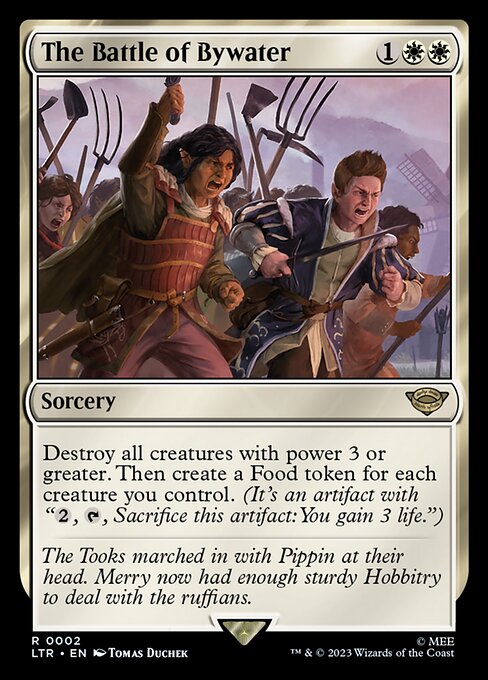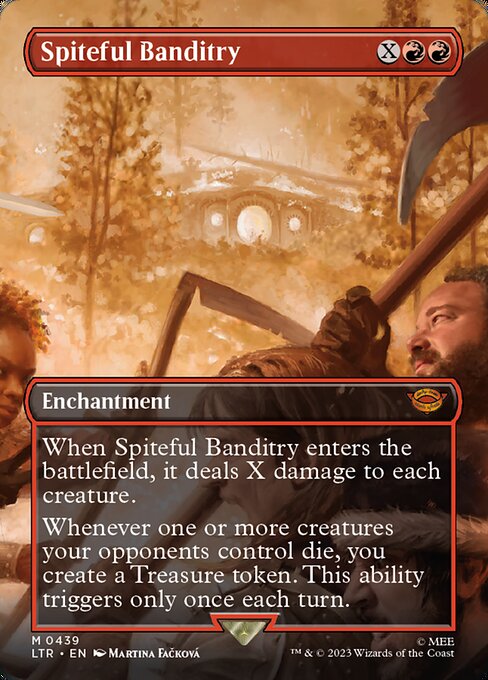Table of Contents
The time has come – new set release is approaching fast. And it is going to be the main thing on Arena for the summer period. So time to get prepared for a long venture into the world of Tolkien. But how difficult is it going to be to kill a Nazgul? Are hobbits pushovers that fold to any removal or is there more to them than it shows on the surface? How many creatures can you club to death with an Improvised Club? Let’s look at the removal in the new set.
As previously, I will look at the four categories of removal spells:
- Unconditional Removal
- Conditional Removal
- Tempo-based Removal
- Sweepers
March of the Machine spoiled us with some excellent removal spells and there is a slight tendency for evaluating he new set through the lens of the previous one. But Lord of The Rings: Tales of Middle-earth (LTR from now on) looks like a strong opposite. The removal suite is not as powerful, there is plenty of medium quality removal in the set, which makes me hopeful for the creature based value engines to be better than they seem at first look. That also means that premium removal will be sought after.
On other hand, creatures seem understatted, so expensive removal spells may be forced to target cheaper creatures, especially when killing the ring-bearer will become a priority and ring-bearer will be at its best as a 1/x creature. This makes for an interesting puzzle to evaluate and what better way to solve the puzzle than by sorting the pieces?

The Lord of the Rings (LTR) Limited Guides
- Tier List - Updated!
- Draft Guide - New!
- Jump Into Middle-earth - New!
- Removal Guide
- Archetypes Guide and Example Decks
- Underperformers and Overperformers
- Combos and Synergies
- Mechanics Guide
- Prerelease and Sealed Guide
- White Review
- Blue Review
- Black Review
- Red Review
- Green Review
- Artifacts, Lands, and Multicolor (Part 1)
- Artifacts, Lands, and Multicolor (Part 2)
Unconditional Removal
Unconditional removal trades cost for certainty. You pay a bit more for the piece of mind that it will deal with any threat. And that certainty is valuable, just think how much better did your deck feel with Deadly Derision in it in MOM. LTR has a decent chunk of unconditional removal, but large part of it comes with cost or flexibility increase that goes beyond what we have seen in recent sets. Still, you probably have to have some amount of removal so you are going to play some amount of it independently of the quality. As usually, most is focused in Black, but both Blue and White have some of this type of removal as well.
Black has 4 spells that can deal with anything, 2 at common, 1 at uncommon and 1 at rare. Lash of the Balrog costs either 1 mana, but you have to sacrifice a creature to make it work, or 5 mana which is quite pricy for a removal spell in modern Magic. This means that if you want to play it, you want to have some dispensable bodies to throw away, and maybe even some cards that give you bonuses for having your creatures die.
In White and Black you have several small token generators, furthermore, you have few legends that create 1/1 Humans or even draw cards when something dies on your turn. In a deck like this Lash looks like a good removal. Another reason to play it is large quantity of Amass in your deck. Putting extra counters on an existing Army is less valuable as creating one, so if you have a 1/1 Orc Army, it may be useful to sacrifice it before Amassing again. Outside of such decks Lash becomes much less valuable. It can’t sacrifice artifacts like many cards of this type do so there are no synergies with food strategies, which means in decks without good sacrifice synergies you should probably only play it if you are short on removal.
Still, it has a solid 58% Game in Hand Win Rate (GiH WR). That means the % of games 17Lands.com users won when at some stage of the game they had Lash of the Balrog in their hand. Keep in mind that 17Lands.com users are usually above average players. Their average win rate is around 56% in Best-of-1, so don’t be surprised if I write about the cards with 53% GiH WR that they are subpar.
Claim the Precious is a prime common removal for the set. 3 mana is a good price but sorcery speed means it will be a 1 for 1 most of the time. But being able to progress your ring progress while getting ahead on board is something that will almost definitely put the card in the top common echelons. At the very top to be precise, with 63.1% GiH WR . Keep in mind that although cheap at 3 mana, you need to have the right mana base to cast it reliably early. BB in the cost of a 3 mana card means you will only be able to cast it on curve 75% of the time with 9 black sources in the deck. Most of the time you want to cast it slightly later, so you shouldn’t worry too much, but double pipped costs are no joke and the design team doesn’t introduce them into the card costs lightly. But given black being very strong in LTR, that is not a big worry.
Bitter Downfall is another premier removal spell in Black. 4 mana instant speed, only one black pip in the cost and a potential to cast it cheaper in some scenarios looks great. And 2 damage to the face is a nice bonus that pushes it across the line. A premier removal that you should very much prioritise when you play black and consider picking early in the draft as a premier uncommon. And the 61.5% GiH WR confirms that.
Isildur’s Fateful Fluke, sorry Strike, is the only Legendary non-permanent spell in the set, which warrants a reminder. You can only cast it if you do control a legendary creature. And that will not always be easy to achieve. But since 90% of non-common creatures are legendary, and the ring-bearer becomes legendary it will be achievable in most decks. You should aim at having 3-4 legendary creatures and 2-3 ways of getting tempted by the ring to play it reliably. If you manage, cards can be extremely good. Same pricing as Bitter Downfall but in some games, especially if you are on the play and cast it early, it will make opponent discard 1-2 cards, which is just great. Make sure you can cast it reliably and you will not regret putting it in your deck. And the cost is real – even though it has similar power than the two removal spells mentioned before, its win rate is only 55.8% GiH WR – not being able to cast is sometimes is a serious drawback.
If Black removal looked impressive, White doesn’t. Fog on the Barrow-Downs is a Pacifism variant. But, it does cost 3 mana, which in recent years needed to have a significant upside to be relevant. But instead of an upside, you get a downside. The fact the creature becomes a Spirit is a very conscious move from the design team – it means if you enchant opponents amassed Army, it stops being an Army, so if they amass again, instead of putting the counters on a pacified creature, they will get to create a new one.
The Pacifism doesn’t stop any activated abilities, triggered abilities and leaves the body behind for any sacrifice abilities. For me to be ok with a card like that – ok – not even happy – it would need to remove all the abilities from the targeted creature. As is, the card is extremely under-rate in my book and I will actively avoid playing it. Still, in the world of no removal, bad removal is king, so I assume I will have to begrudgingly play it from time to time – and even worse – sacrifice early picks to get it. But the early data doesn’t look impressive for Fog on the Barrow-Downs, with a measly 52% GiH WR.
Banish from Edoras is a 5 mana sorcery speed removal, which is too expensive for modern Magic. It can cost less if you target a tapped creature but at sorcery speed this means the target already did some damage before you deal with it which is not great. Exile doesn’t do much in this set so the fact it does it is a minor upside.
My only hope for this card is it will not be picked as high in the draft as the new Pacifism, so I will be able to pick it later, thus not having to sacrifice much to have it in my deck. And given white removal quality – I will probably have to play it on occasions. Still, 53.7% GiH WR is not impressive in any conceivable way.
Blue unconditional removal in the set looks decent. Bewitching Leechcraft is one mana cheaper than the Fog on the Barrow-Downs, which is a complete turnaround from recent years where the blue tap aura was on average more pricy than its white equivalent. It has the same drawbacks as the white one – doesn’t deal with the creature permanently, doesn’t neutralise Army completely, but the one mana decrease in cost is making up for it somewhat.
Early data with 52% GiH WR suggest I might need to be looking for removal solutions in blue elsewhere. I am not thrilled to play it but it is one of the few things in your blue decks that can deal with things that somehow managed to hit the battlefield.
Why wouldn’t they hit the battlefield? Well the other unconditional removal in blue are two great counterspells. First of them, Glorious Gale is a strictly better Essence Scatter. Essence Scatter was solid to great card in formats it appeared in, so an upgraded version should be just what you want. Can deal with early stuff, not dead in the late game and frequently will progress your Ring upgrades as, as I mentioned, 90% of non-common creatures are Legendary. What is there not to like? One knock against it is the possibility of creature-light spells decks, but even then, ring-bearer allows you to loot it if you see it might be less useful in the matchup. And the numbers confirm it, Gale being the top blue common with a solid 58.8% GiH WR.
Saruman's Trickery is one mana more expensive and is a bit heavy on the blue, making all the warnings that apply to Claim the Precious apply to it as well, but Cancel that makes a 1/1 creature is a very good rate for a counterspell. And it can counter anything so you will always find a good use for it. If playing counterspells, I would advise to also have few instants in your deck, so even if opponent doesn’t play anything, you can still use the mana efficiently. Nothing worse than leaving 3 mana for a counter only to not use it. Saruman's Trickery is a frontrunner for the best blue uncommon in the format so far with a GiH WR of 61.6%.
Conditional Removal: Fixed Damage
Damage based removal is focused in red, however usually is also makes an appearance in black, where “damage” comes in the form of giving a creature -x/-x to a creature. How good damage removal is links to the rate of cards involved and the distribution of toughness in the format. My way of looking at it is to test, what percentage of creatures are killed at each level of damage based spells.
So for example, if there is a Shock in the format – what fraction of creatures are killed by it outright. Because common creatures, uncommons and rares are usually sized differently (rares are usually slightly larger), I split that data into rarity categories. In the end, you will be facing many more commons than bomb rares, at least that is the hope.

Looking at this data, there are typical amounts of 1 and 2 toughness creatures in LTR. What is slightly different, is the quick saturation of those graphs – there are barely any creatures with power more than 4 – which, for example, could mean a card like Improvised Club will be better in this format than in some others where 5 toughness creatures are more prevalent. Of note, there is only 1 uncommon with power higher than 4.
But, as I mentioned, smaller creatures are at the relatively standard frequencies. 27.7% of the commons are X/1s. That is slightly above the average, but lower than sets like SNC or BRO. What does it mean to a card like Cast into the Fire? Problem with such spells is, even if they find a target, it will, most likely, be a low impact one. And there are not many impactful artifacts in the set which means the second mode of the card will be rarely useful. Even with several cards that produce 1/1 tokens, I would be very cautious to introduce this card in my deck – red has much better alternatives. And data confirms it. 53.4% GiH WR is very low for red, one of the best colors in the format so far.
46.8% of the common creatures have toughness 2 or less. This is actually on the low side – some sets like SNC or MID had over 60% of common creatures in this category. Still, half is a lot and lot of Amass effect produce 1/1 or 2/2 armies that you can kill with this spell. And it does generate the “Ring tempts you” effect which is quite valuable, especially in red decks that don’t have many enablers for that, and would want to progress ring to level 2 and start looting the lands away.
Ranger's Firebrand looks very good because of that and because one mana is an excellent cost. There are some impactful creatures costing 3 mana with 2 toughness in the set. It is probably because of all those factors that Ranger's Firebrand has very solid win rate – 62.4% GiH WR puts it in the top uncommon echelons and should be picked accordingly.
Two mana instant, deals 3, exiles target, deals with indestructible creatures? Sign me in! This was widely speculated to be the top red common in the format. So far it isn’t, but it is not far off. Dealing with 75% of common creatures while being able to kill some of the most annoying bombs like Witch-king of Angmar and Arwen, Mortal Queen (who ironically is not very mortal if its controller doesn’t want it to be) is a decent range for a common. 60.4% GiH WR puts it second in terms of red commons, but red is strong so you should pick it often and with no worries about your decision.
Improvised Club is an odd one. Apart from the mana cost, you will need to sacrifice either a creature or an artifact, so you need to make sure that your deck can create board states where that is possible. But a big plus of the card is, it can go face, potentially acting not only as removal but also as a finisher. There are plenty of 1/1 creatures, Amass 1 spells, Food, Treasure tokens you can use to improvise the club with. Sometimes you can even trigger a death trigger with it for extra value, like sacrificing Rohirrim Lancer to get tempted by the ring. Cards like this definitely don’t fit in any deck but with small concessions in draft and deckbuilding can be pretty good. And so far Improvised Club exceeds the expectation as one of the top red commons with 59.4% GiH WR.
Red is not the only color with the damage based spells. Black ones are mainly giving their targets -X/-X rather than direct damage, which has its pros and cons. Gollum's Bite is a variant of Disfigure with an upside. Instant speed -2/-2 is in most cases better than deal 2 damage. You can use it during combat to turn opponent’s 3/3 into a 1/1 which lets you win the combat. Be careful with this type of application though, as opponent might have an instant response that will make you lose two spells to their one.
But the key part of Gollum's Bite is the ability to exile it from your graveyard to get tempted by the ring. Since you choose when to use it, it becomes a valuable tool, enabling attacks, activating extra levels of the ring. This also means Gollum's Bite has value even if it was milled – small upside in a set with some amount of self-mill in blue and black.
All in all a solid removal that allows you to stay in the game if you play a control deck and to get ahead if you are pushing aggressive strategy while one mana can let you kill something and still progress the board state by playing a 2 – 3 mana creature. Its win rate is excellent even taking into account the power of black in this set. 63.3 GiH WR is truly excellent.
There is one more removal spell using direct damage, a rare one in UR. Flame of Anor gives its caster a choice. 5 damage to any target, drawing 2 cards or destroying target artifact. The damage and draw modes are going to be by far the most popular ones, but if you really need to kill a bomb-level artifact, you will be very happy to have that option. But wait, there’s more. If you control a Wizard (which in this set will be most likely one of the Gandalfs or Sarumans), you get to chose two of the three modes. And that pushes it to truly excellent.
Still, even one of the modes is great – 5 damage for 3 mana is way above rate and extra flexibility adds more value to the card. A real star in your UR or Grixis spell decks. 57.2% GiH WR is not incredible, but UR is a deck with middle of the field win rate. You will still want to play any copy of it in those decks and you might get the card relatively late for a rare, as only other Izzet players and rare-drafters will be interested in picking it. With ALSA of 3 it won’t wheel but you will be able to get it pick 5-6 in some pods (to see how to use ALSA to predict cards wheeling, see this article).
Conditional Removal: Scalable Damage
But not all damage spells do predictable amount of damage. There are fight, bite spells that depend on your creature’s size, conditional damage spells where the amount is dependent of mana paid, creatures you have or cards in your graveyard. And some of those are excellent and things you might want to play around.
This 2 mana white instant is growing to be the best white removal at common. White is filled with cheap creatures, and Food generation is not that hard, meaning Hobbit's Sting will occasionally deal with very large threats for a cheap price. It will on occasions do nothing, and that fail state needs to be factored into the card’s power.
Still, at 56.1% GiH WR it is by far the best white removal at common so far and you should pick it over the Fog on the Barrow-Downs or Banish from Edorasin most if not all cases.
Fight spells are one of the riskiest card categories of limited cards. If something goes wrong, opponent has a response to you casting it, you can get easily 2-for-1ed. And that spells disaster for your game. But in this format lots of removal is at sorcery speed and Ent's Fury helps your creature to win the fight by giving it at least +1/+1 until end of turn and potentially, even +2/+2, half of it permanently. This puts Ent's Fury on top of green commons.
But even so, the GiH WR is a less impressive 55.8% – mainly because green, so far, is quite disappointing in LTR. Still if you end in a green deck, you might want to pay close attention to Ent's Fury and cards that play well with it, like the surprising green overperformer, Mirrormere Guardian.
Stew the Coneys, AKA Rabbit Bite, is a bite spell. This carries less of a risk in the game, as it can’t be blown out completely with a combat trick. But the spell itself doesn’t boost the biter’s stats which makes it much weaker than some historically powerful bite spells like Clear Shot. Card still suffers from low power of green, but has comparable stats to the previous card at 55.1% GiH WR.
Friendly Rivalry is a RG bite spell that lets two creatures join their forces in killing another creature. The cost is decent, ability to tag team opposing large creature or use two individually lethal creatures to minimise the probability of a blowout is fine, but the spell is in a low win rate archetype. And that means the win rate is probably dragged down by it. If Gruul decks improve over time, so will Friendly Rivalry. But so far, 54.6% GiH WR doesn’t impress. It is likely though, that at least part of RG decks are built sub-optimally – so there is hope that this card will improve with time.
This peculiar bite spell uses opponent’s creatures. This will most likely result in killing of opponents second best thing on board and you get to be tempted by the ring. It will be a dead card some of the time, when opponent has only one creature on board, or when powers and toughnesses don’t align well. But despite this serious problem, card is overperforming by quite a lot. Some of it might be attributed to the quality of red in general, but even at this early stage of the format, 56.7% GiH WR can’t be completely swiped aside as a result of a small sample size. Not a premium but a respectable filler in red decks until proven otherwise.
This is the Flametongue Kavu variant for this set. At least a 2/2 that deals 2 damage, but very frequently becomes a hasty 4/4 that deals 4 to a target, and even more. Some blowout potential so make sure opponent can’t respond to it, or that you have emergency target with 2 toughness when you play it but that card can rarely go wrong. First pick lots of times, one of the top uncommons in the format – and data confirms it with a juicy 62.9% GiH WR.
I said one of the top uncommons, but Foray of Orcs was not even the top red uncommon. This spot so far belongs to Fear, fire, Foes! with 64.7% GiH WR. Scalable removal has a huge range in limited. Some is just so underpowered, that it is a filler, but adding something extra can quickly make it into a bomb. And that was the case here – dealing 1 to every other creature opponent controls will frequently kill 2+ creatures on top of the main target. 1/1 creature tokens in Humans and Spirits will fold to the power of this card. Another likely first pick that any red decks wants unlimited numbers of.
A removal that in the right deck can quickly turn into a game winning spell. In UR filled with spells synergy it can easily deal 12 damage, so targeting a 1/1 will deal 11 face damage. If playing that strategy – be extra careful with selecting the target. Opponent sacrificing the target in response can lose you a game on the spot. In decks that rely on this strategy, you might want to play a copy of Treason of Isengard or The Bath Song to make sure you get a second shot at casting it. The card you will fear the most while playing the combo plan is The Torment of Gollum which can successfully ruin your plan while eluding most of your counterspells. And sometimes it will be just a very solid removal for a large creature that deals a couple of extra points of damage to its controller which is also great.
Yes, this is a build-around card, but it is an easy one – just put spells in, making sure some of the spells are creatures. For an example list, you can check my 7-0 version – and yes, that is a brag. 60.4% GiH WR suggests that the card, although not close to Zenith Flare power, as some pre-release analyses suggested, is still a very powerful tool.
Conditional Removal: Other
Every set has some quirky removal spells. Sometimes they look at target’s type, power, key words or color. This set is pretty poor in this type of removal for some reason, however some spells are still there and some look quite interesting and powerful.
But not this one. Few targets, no important artifact creatures – all make Shower of Arrows unplayable in main deck. May be an option in the sideboard if you notice opponent has some powerful artifacts or enchantments. GiH WR of 47.3% is poor even in weak green. Avoid at all costs.
Normally I advise to do what the card says, but in this case, you definitely can pass You Cannot Pass! to the next player. It is too situational, will be dead in your hand too often. Unless you are playing some really legend heavy deck, you might want to give You Cannot Pass! a pass. 52.4% GiH WR at an uncommon is not encouraging, but potentially there are decks that will benefit from having a copy and the card goes pretty late, so you should be able to get it then.
Now we’re talking. Lost to Legend realistically will only be able to target Legendary creatures, but keep in mind that this is 90% of all non-common creatures plus any ringbearers. And from time to time you will be able to ruin loop-de-loop plans of someone with thin library and The Bath Song in play by making sure they will mill out before they can reach chapter 3 of this Saga. Burying a creature 4 cards deep in the library will frequently be equivalent to killing it outright. And killing something for 2 mana is a great rate, especially for a white spell.
It comes as no surprise in that case, that Lost to Legend is one of the solid white uncommons, with a GiH WR of 56%, far better than any other white removal spell we discussed.
Last of the conditional removal is another blue counterspell. Stern Scolding can counter a creature spell with either power or toughness 2 or less. And that means surprisingly a lot.

Two thirds of common creatures, 60% of uncommons and 40% of rares fall to this one mana spell. It is not as powerful as the other two counterspells we discussed above, but has a home in some spell based controlling decks. It becomes much better if you are tempted by the ring a lot, as, when you see a matchup you think it is not great, you can always loot it away in hope of getting a more useful card. GiH WR is a respectable but not impressive 55.8%.
Tempo Removal
Tempo removal is a perfect tool for procrastinators. It doesn’t deal with the problem permanently, but postpones it, usually at a competitive mana cost. This gives you time to either stabilise, or in case of aggressive tempo decks, kill the opponent. Tempo removal is a domain of blue, but in this set we also have a good white tempo spell.
A two mana bounce spell that gets you tempted looks unimpressive. And it won’t deal with opposing armies. But tempo spells can be deceiving, and they always tend to look unimpressive, especially to beginner players. In reality Soothing is one of the top blue commons with a GiH WR of 57.7%. It can lead to 2-for-1s, turn a good attack from an opponent into a disaster and puts you ahead on mana spent and, with blue’s impressive counterspell package, can set you up for getting rid of the creature that troubles you permanently. Great tool for controlling and tempo decks like UR or UB.
This type of spells is always both undervalued and overperforming. In this iteration, opponent can’t chose to put the targeted card on the bottom of their library, which will sometimes force them to draw something they are not interested in drawing at that stage of the game. It can also permanently deal with an army. Four mana is a bit harder to keep up, so experienced players will be able to play around it, but again, with a bunch of counterspells in the format it is a good tool to have to be able to use mana efficiently if no target for the counters will appear. 57.4% GiH WR is solid and card should be drafted as a solid piece of cardboard in blue decks.
Bouncing two creatures will be a large tempo swing any time. The scry and getting tempted on top of it is a nice bonus. This card also deals with armies so gives you a fighting chance against the RB menace. 5 mana for this effect is pretty good a price. And it shows in the data. at 58.1% GiH WR this is the second best blue uncommon, but keep in mind, that this type of tool is more potent in the hands of an experienced player so if you are starting to play limited, you may be careful to play with it and use it as a learning opportunity for your next level-up.
This is a card you most likely have to know is good. That effect looks poor to vast majority of beginners. But spending 2 mana to ruing a timely play by your opponent or even trading 2 mana for 5-6 they played, and getting ready to what is coming soon is an excellent deal and a back-breaking tempo play. Requires some setup but it is worth playing. One of the better white cards at 57.3% GiH WR.
Sweepers
The most dreaded category of removal. There’s nothing worse than building a superior boardstate just to have the slate wiped clean. Oh, well there is something worse – and it is the realisation that opponent was planning it all along and soon they will have a formidable board and you will be on the back foot. Luckily for those of you who passionately hate sweepers, not many of those in the set. But be prepared for the ones below.
A minisweeper. Sometimes cards like that are ok. Most of the time, when they are at instant speed. And when the format aligns well against X/1 creatures. As it turns out, The Black Breathis a sorcery and the card performs poorly for black in LTR. Only 54.6% GiH WR makes it a weakest black common in terms of win rate. No loss – black commons and black removal are plenty powerful without yet another tool in their arsenal.
A novel take on a one sided wrath of god effect. Battle of Bywater requires some playing around it, building the right deck, but once you end up there – you have a solid card. 58% GiH WR is on the lower side of white rares but it is very close to the top as they do have a relatively flat power level. May evolve either way in time but for now – worth playing.
Heralded to be a new The Meathook Massacre, it most certainly is not. The static effect on the Meathook was a large chunk of its power. And the static effect on the Banditry is much much weaker. Still a very good card with 59% GiH WR but not an unbeatable bomb some were speculating it to be before the set released. Keep in mind – 6 red uncommons have a higher win rate than Banditry does. Still, if a red opponent is suspiciously shy on putting creatures on board while you do so – pay attention. If they drew badly, you will still likely win without overcommitting to the board, but if they have a sweeper, you might be in deep trouble if you put all eggs into one basket.
And the last card. What better to keep for the last in the Lord of the Rings themed set than One Ring To Rule Them All? Unfortunately the card itself is not a bomb by any stretch of imagination. Situational utility and giving the chance to the opponent to prepare for it means it won’t be backbreaking a lot of the time. 55.8% GiH WR is not incredible for black in LTR. It will be great sometimes though so it is not a complete write-off, or maybe even a solid sideboard card in best-of-3.
Hope you enjoyed the removal review and it will help you trophying in the Arena drafts in the coming weeks!
Premium >
Enjoy our content? Wish to support our work? Join our Premium community, get access to exclusive content, remove all advertisements, and more!
- No ads: Browse the entire website ad-free, both display and video.
- Exclusive Content: Instant access to all exclusive articles only for Premium members, at your fingertips.
- Support: All your contributions get directly reinvested into the website to increase your viewing experience!
- Discord: Join our Discord server, claim your Premium role and gain access to exclusive channels where you can learn in real time!
- Special offer: For a limited time, use coupon code L95WR9JOWV to get 50% off the Annual plan!


























